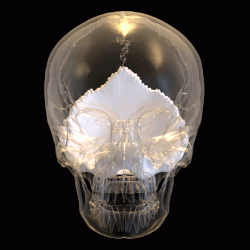| Occipital bone | |
|---|---|
 Position of occipital bone | |
 Animation of the occipital bone | |
| Details | |
| Articulations | The two parietals, the two temporals, the sphenoid, and the atlas |
| Identifiers | |
| Latin | os occipitale |
| MeSH | D009777 |
| TA98 | A02.1.04.001 |
| TA2 | 552 |
| FMA | 52735 |
| Anatomical terms of bone | |
The occipital bone (/ˌɒkˈsɪpɪtəl/) is a cranial dermal bone and the main bone of the occiput (back and lower part of the skull). It is trapezoidal in shape and curved on itself like a shallow dish. The occipital bone overlies the occipital lobes of the cerebrum. At the base of the skull in the occipital bone, there is a large oval opening called the foramen magnum, which allows the passage of the spinal cord.
Like the other cranial bones, it is classed as a flat bone. Due to its many attachments and features, the occipital bone is described in terms of separate parts. From its front to the back is the basilar part, also called the basioccipital, at the sides of the foramen magnum are the lateral parts, also called the exoccipitals, and the back is named as the squamous part. The basilar part is a thick, somewhat quadrilateral piece in front of the foramen magnum and directed towards the pharynx. The squamous part is the curved, expanded plate behind the foramen magnum and is the largest part of the occipital bone.
Due to its embryonic derivation from paraxial mesoderm (as opposed to neural crest, from which many other craniofacial bones are derived), it has been posited that "the occipital bone as a whole could be considered as a giant vertebra enlarged to support the brain."[1]
- ^ Nie, Xuguang (2005). "Cranial base in craniofacial development: Developmental features, influence on facial growth, anomaly, and molecular basis". Acta Odontologica Scandinavica. 63 (3): 130. doi:10.1080/00016350510019847. PMID 16191905. S2CID 1091809 – via Taylor & Francis Online.